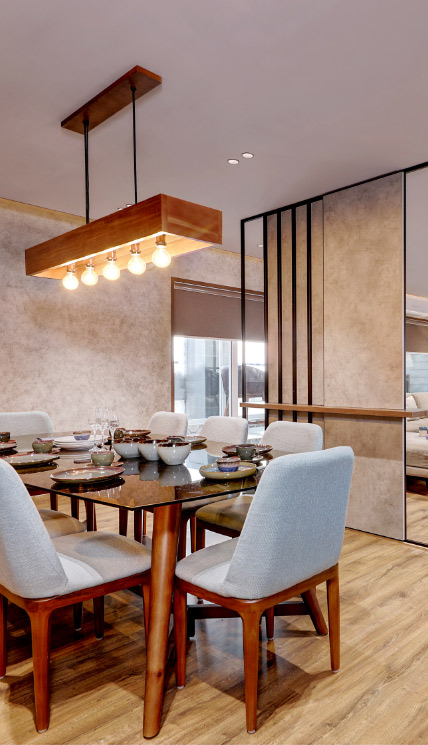Hire skilled interior design firms that redefine elegance.
Hire skilled interior design firms that redefine elegance.
Blog Article
Transform Your Home With Essential Principles of Interior Design and Aesthetic Appeals
By recognizing the impact of shade concept and the relevance of structure and patterns, one can develop spaces that are not only visually enticing however likewise deeply personal. Achieving this balance entails even more than plain design; it incorporates a critical arrangement and an eager understanding of how each aspect connects within a room.
Recognizing Color Theory
Shade concept is a fundamental element of interior decoration that dramatically influences mood, understanding, and overall aesthetic. Recognizing the principles of shade theory permits designers to create rooms that resonate emotionally with residents while fulfilling functional demands (luxury interior design). Shades can be classified into three key kinds: main, second, and tertiary. Each category plays a crucial duty in establishing consistency within an area.
The mental influence of shades is extensive; warm colors such as reds and oranges evoke energy and heat, while amazing tones like blues and environment-friendlies promote calmness and tranquility. In addition, making use of complementary colors boosts aesthetic passion, creating striking contrasts that can boost an area's allure.
Neutral shades, on the various other hand, work as a versatile backdrop, allowing other style aspects to shine. It is necessary to think about aspects such as lighting and the space's purpose when choosing a shade palette, as these can change the perception of colors throughout the day.
Ultimately, a well-considered color pattern can change an area, cultivating a feeling of convenience and style that lines up with the inhabitants' preferences. Mastery of shade concept is, for that reason, an essential ability for any kind of indoor developer intending to develop harmonious and inviting atmospheres.
Achieving Equilibrium in Design
Just how can designers attain a feeling of stability in their areas? Achieving balance in design is basic to creating harmonious insides.
Unbalanced balance, on the other hand, depends on differing aspects that still achieve a natural look. This technique enables even more vibrant and informal arrangements, providing rate of interest while preserving stability. By carefully selecting varying sizes, colors, and appearances, designers can create a visually compelling space that feels balanced yet energised.
Radial balance emphasizes a main focal factor with components emitting exterior. This design is frequently seen in round designs, where furnishings and decoration produce a cohesive surround that attracts the eye internal.
Ultimately, achieving equilibrium calls for thoughtful factor to consider of scale, percentage, and the connections in between components. interior design firms. By skillfully applying these equilibrium concepts, developers can change spaces right into settings that feel both visually pleasing and functionally unified, improving the total experience for passengers
Importance of Spatial Recognition

An eager feeling of spatial understanding permits developers to determine prime focus within a space, directing the viewer's attention to vital functions while preserving an overall sense of unity. It also assists in the critical placement of illumination, which can substantially affect the understanding of space and mood. Recognizing spatial connections allows the developer to cater to the specific needs of occupants, making sure that each area offers its intended function without jeopardizing aesthetics.
Ultimately, spatial recognition is critical for making the most of the possibility of any kind of interior area. By very carefully thinking about the interplay between measurements, format, and feature, developers can develop settings that not only meet sensible needs however additionally stimulate a feeling of convenience and elegance, enhancing the overall living experience.
Incorporating Texture and Patterns
Embracing a diverse variety of appearances and patterns can considerably improve the aesthetic and responsive allure of an indoor area. The tactical use numerous materials-- such as timber, steel, fabric, and rock-- produces depth and interest, making a room feel website link a lot more welcoming and vibrant. Combining smooth surface areas with harsh structures can establish an equilibrium that attracts the eye and involves the senses.
When integrating patterns, take into consideration both range and repeating. Big patterns can function as prime focus, while smaller sized, refined layouts can enhance various other elements without overwhelming the area. Layering patterns, such as pairing floral cushions with candy striped throws, includes complexity and a feeling of consistency if executed thoughtfully.
It is also essential to preserve why not try here a cohesive color palette, making sure that appearances and patterns interact instead of compete for focus. By picking a couple of essential structures and patterns, you can create an unified aesthetic that shows your personal style while improving the general ambiance of the room. Ultimately, the careful incorporation of these elements can change a mundane area right into an advanced environment abundant with personality and warmth.
Customizing Your Area
Producing a space that mirrors your character is crucial to achieving a genuinely inviting environment. Customization in indoor style enables you to instill your one-of-a-kind design and passions into your home, transforming it from a simple shelter into a haven that talks to that you are. Begin by picking a shade palette that reverberates with your emotions-- strong colors can stimulate, while soft tones offer peace.
Include art work and decor that reflect your enthusiasms, whether it be travel, nature, or abstract ideas. Presenting individual collections, such as books, pictures, or keepsakes, can evoke cherished memories and produce prime focus within a room. In addition, consider customizing useful items, like upholstered furniture, to align with your visual preferences.

Verdict
Finally, the change of a home via the Full Article important principles of interior decoration and aesthetic appeal necessitates a detailed understanding of shade concept, balance, spatial awareness, appearance, and personalization. Each component adds dramatically to developing an unified and useful living environment - luxury interior design. By thoughtfully incorporating these principles, people can improve the visual appeal and emotional vibration of their rooms, inevitably fostering a home that mirrors distinct identities while giving convenience and usefulness
Report this page